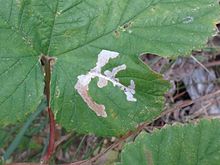Cosmopterix zieglerella
| Cosmopterix zieglerella | ||||||||||||
|---|---|---|---|---|---|---|---|---|---|---|---|---|
| Systematics | ||||||||||||
|
||||||||||||
| Scientific name | ||||||||||||
| Cosmopterix zieglerella | ||||||||||||
| ( Huebner , 1810) |
Cosmopterix Ziegler ella is a butterfly ( moth ) from the family of cosmopterigidae (Cosmopterigidae).
features
The moths reach a wingspan of 8 to 11 millimeters. The head shines golden metallic and shimmers dark brown at the back. A thin white line runs down the sides above the eyes. The antennae are dark brown and have a subapical area made up of three white segments and an apical area made up of five white segments. The labial palps are white, the second segment has a glossy, dark brown dorsal line. The third segment has a shiny, dark brown ventral line and a dark brown tip. The thorax is dark brown and has a golden metallic shining line. The tegulae are golden metallic. The forewings have a dark brown sheen and a gold-colored band at the base of the wing that runs diagonally outwards. A light, orange band is in front of the middle of the wing. It tapers towards the inner edge of the wing and is surrounded by an irregular line of dark brown scales . Inside and outside there is a pale golden, shiny band, which is often tinted slightly purple. The outer band has a small white spot on the Costa loader. The hemline is reduced to a silvery spot with a bluish sheen in the middle and a light white spot at the apex that extends into the fringed scales. The fringed scales are dark brown. The hind wings are dark gray-brown.
In the male, the right brachium is spatulate, tapers slightly distally and ends in a blunt apex. It is three times as long as the left brachium. The valves are rounded, the upper and lower edges are concave, the caudal edge is convex. The valvellae are slightly curved and tapered towards the base. The widest part is in front of the middle, the valvellae taper distally to a blunt point. The aedeagus is quite flat and has a bulbous central part. Apical it is tubular and slightly curved downwards.
In females, the rear edge of the 7th sternite is almost straight. The 8th sternite is twice as wide as it is long. The ostium bursae is round and crescent-shaped sclerotized , below is a small, comb-shaped sclerotization. The sterigma is inversely pear-shaped and elongated. The ductus bursae is slightly shorter than the corpus bursae . The corpus bursae is provided with two small, sickle-shaped signs of different sizes.
Similar species
The similar species Cosmopterix schmidiella differs from Cosmopterix zieglerella by the uninterrupted seam line on the front wing.
distribution
Cosmopterix zieglerella is native to Europe, Asia Minor , the Caucasus , Central and East Asia and Japan .
biology
The caterpillars develop on real hops ( Humulus lupulus ), Japanese hops ( Humulus scandens ) and Boehmeria nipononivea . The females lay the eggs on the mid-ribs or other large veins of the leaves. The feeding activity of the young caterpillars creates an irregular elongated mine with a silky feeding tunnel along the leaf vein. It serves as a shelter for the caterpillars when they are not eating. Starting from this passage, the caterpillars later branch out in all directions, creating a very irregular, yellowish-white space mine in which the caterpillar droppings are distributed. The caterpillars can change the mine, in large leaves there can also be several mines. The caterpillars can be found from July to September. In autumn they make an elongated, white cocoon and hibernate in it in the detritus on the ground. The moths fly from late May to July and can be knocked out by the host plants. Occasionally they come to light too .
Systematics
The following synonyms are known:
- Tinea zieglerella Huebner , [1810]
- Gracillaria eximia Haworth , 1828
swell
Individual evidence
- ↑ a b c d e J. C. Koster, S. Yu. Sinev: Momphidae, Batrachedridae, Stathmopodidae, Agonoxenidae, Cosmopterigidae, Chrysopeleiidae . In: P. Huemer, O. Karsholt, L. Lyneborg (eds.): Microlepidoptera of Europe . 1st edition. tape 5 . Apollo Books, Stenstrup 2003, ISBN 87-88757-66-8 , pp. 109 (English).
- ↑ Cosmopterix zieglerella at Fauna Europaea. Retrieved December 30, 2011
Web links
- Lepiforum e. V. - Taxonomy and photos
- Ian Kimber: Guide to the moths of Great Britain and Ireland (English)
